|
The mural “Muses of the Mountains” for the Breathitt High School stage proscenium is complete. This mural hearkens back to the roots of theatre, connects it to modern-day Breathitt County, Kentucky, and pays homage to an older mural that graced the stage of the former high school building.
The theme of the mural is ancient Greek origins of theatre meet the contemporary arts of Breathitt County, Kentucky. Faculty and students were able to provide input for elements of the mural to connect it to Breathitt today. Stylistically, this mural takes ornamental cues from the motifs and structures of classical Greek and Roman architecture while relating the subject matter to Breathitt County. The painted bas-relief that spans most of the top depicts processions of wild horses and the elk herd for which Breathitt is known. The horse motifs are taken directly from those of the Parthenon Marbles of Athens. The centerpiece is comprised of theatre masks, lyres, and a statuesque mask of the Greek god of Theatre. The motto underneath “All the World’s a Stage…” was voted upon by the community and links this new mural back to the stage mural at the old high school. The four figures flanking either side of the stage are based on Greco-Roman marble statues representing four of the nine muses of the arts and inspiration. These four are Thalia (Theatre/Comedy), Melpomene (Theatre/Tragedy), Euterpe (Music/Lyric Poetry), and Terpsichore (Dance/Choral Song). Two of them are depicted with contemporary Appalachian instruments voted upon by the community (one holds a mandolin, the other has a mountain dulcimer). They each appear in an arched nook that resembles the night sky. This was painted in fifteen roughly 4.5' x 5’ sections of Polytab in studio and then permanently installed on site.
0 Comments
I'm so excited to be nearing completion of painting the Cumberland Dragon mural for Appalshop's Boone building in Whitesburg, Kentucky. This 55-foot by 12.5-foot mural is being painted remotely in studio on a material called Polytab, which is a non-woven fabric that will be permanently installed onto the building in a process similar to wallpapering. This allows for more detailed painting and less time at the mercy of the elements. The paint is acrylic, from a California-based company called Nova Color. I’ve been so happy with their products with this, the pigment load is high and the colors are vibrant and stunning in the sunlight. The photo above is the bottom half of the mural.
As far as the subject of this mural, The Cumberland Dragon a.k.a. "Goosefoot" is a regional cryptid that, according to legend, resides in the Cumberland Mountains region of the Appalachians. It was reportedly sighted in the 1790's by a group of soldiers. To read the legend, this site has a description of it from a newspaper in 1794: https://cryptidz.fandom.com/wiki/Cumberland_Dragon My depiction of it as a wingless drake is inspired by Southern Appalachia's reputation as a salamander hotspot, having the highest biodiversity of salamander species on Earth. The design of the face of this dragon is the result of a multitude of sketches with inspiration from my dog's (a Pitlab) face, characters from Netflix's "The Dragon Prince", and the colorful dragons from "The Legend of Zelda: Breath of the Wild". The dragon itself is very much part of the landscape. Its scales resemble leaves. Moss grows on its back alongside the leafy spine. Little mushrooms bloom from the moss, and craggy turkey-tail fungi grows from the dragons legs and arms. It's hiding in the Mountain Laurel, which blooms in the mountains of Appalachia, another homage to the original legend. This region is also known for its lightning bugs. Summer nights are like a light show, with hundreds of them sparkling in the trees and bushes. Here they illuminate the dragon, ferns, and laurel. The building this will be installed on was once a car dealership called the "Boone Motor Company". As an homage to that fact, the right side of the mural has a tree with the name carved into it, an old tire is being reclaimed by nature, and a vintage truck is being abducted by a UFO. The mural will be installed in September. I’ll be sharing more information, photos, and video of the process once it’s complete! Below are a few progress photos. "Solastalgia", a neologism for the grief and anxiety felt about global climate change and environmental destruction, both local and global. This is the title of one of my currently in-progress oil paintings. It's the overwhelming sense of grief and the paralyzing feeling and fear of not being able to do anything to stop climate change. It's the mourning of the loss of life on Earth, and ultimately the loss of ourselves. It's the frustration of knowing what's happening, and the recognition that humans should never have placed themselves above nature as master. It's a heavy subject, and some days, difficult to paint on. This painting has a second name - "The Dryad in Winter", where the dryad is mourning the seasonal "death" of the forest. It quickly became more than that. Let's hope (and actually take action to make sure) that this part of human history is just a temporary season of death, and that spring will come. On more technical terms, my style of painting is evolving, but it's a back and forth between expressive brushwork and controlled, well-planned glazing with forms and light aiming to recall the wonderful chiaroscuro figures of the baroque masters. This work is on linen, not my go-to birch panels. I like it slightly better than cotton, but I think birch panels will always be my preference. To read more about the word "solastalgia" and the philosopher who coined the term:
https://qz.com/1423202/a-philosopher-invented-a-word-for-the-psychic-pain-of-climate-change/ 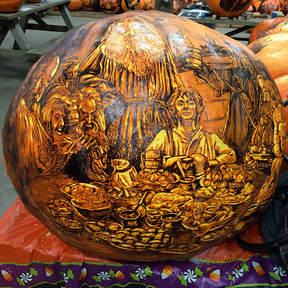 A work in progress shot of my 2015 Jack O'Lantern Spectacular pumpkin of the scene from The Hobbit "Unexpected Party" A work in progress shot of my 2015 Jack O'Lantern Spectacular pumpkin of the scene from The Hobbit "Unexpected Party" Another great Fall season of jack o'lanterns has come and gone. In this, my 4th year, I was able to create a grand total of 18 of these pumpkins this year from September to end of October. If you jump over to my 'Pumpkins' tab on the menu bar, you can see many of these. A little background (taken from the Louisville Jack O'Lantern Spectacular's About page): "The Jack-O-Lantern Spectacular began in Oxford, Massachusetts in 1988. It’s entertainment for the entire family. The Louisville event, October 12– November 5, will be held in Iroquois Park with 5,000 carved pumpkins lining a ¼-mile walking trail, illuminated at night as an “art show” daily from dusk to 11 p.m. during the week (Sunday-Thursday) and midnight on Friday & Saturday." Many people ask how I got involved with this. The answer is that I was browsing the Art/Design job section of Craiglist (always a bit scary), and discovered a post that was looking for local artists to hire to come be a part of this at their pumpkin studio at Iroquois Amphitheatre. I thought, "let's just see what this is all about", and sent them my portfolio. Before I knew it, I was drawing and carving on massive pumpkins in a great Fall/Halloween themed theatrical visual art event that I look forward to every year. There are about 140ish intricate pumpkins on the trail, and almost 5,000 other jack o'lanterns lining the trail and up in the trees. Each year comes with a new overall theme, with the trail then being broken down into small sections or "skits" that fit within the overall theme. People come from all over Kentucky, Indiana, Ohio, and even further to see our work. Another question I get asked a lot is how long these take to make. This always depends on the size of the pumpkin "canvas", and the intricacy of the work that is to go on it. My fastest pumpkin was probably this enormous sea turtle I made this year, my attempt at turning a large, flat pumpkin into the illusion of a giant sea turtle. It took probably about 5 hours to draw, and then about 2 hours to carve. I think the one that took me the longest was from 2015, a Hobbit themed pumpkin depicting the scene of the Unexpected Party, where the dwarves and Gandalf show up at Bilbo Baggins house and a large feast ensues. I spent days drawing, and all the food was particularly tedious to figure out. The carving went slightly faster. Unfortunately, the weather wasn't especially cooperative that year, and that pumpkin only lasted 3 days on the trial before it died, which really hurt. Which brings me to the next combo question I am often asked... "Is there any way to preserve them? It's a shame to do all that work for something that is so temporary!" With good, dry weather, cool temperatures, and few squirrels, these will sometimes last 3-4 weeks at most. That is with scraping out mold, spraying with different things, etc. I suppose in theory you could attempt to permanently preserve these, but I'm not sure that it would work. As far as it being so much work to create such a beautiful but temporary thing, to me it's part of the beauty and appeal of it. It's the ephemeral, fleeting nature of these that adds a level of thought-provoking beauty. These are living canvases with a life, a very short one. The artists spend hours and days making something wondrous and amazing, only to watch it slowly (sometimes quickly) whither away. It's sort of reflective of our own lives and the reality of life in general. We have such a brief moment to make a difference, do big things in our own ways before we start to whither and pass on. It's interesting to make art that is not permanent, that has a life of its own, and that exists in time. Of course it's always sad to see them go, but it's fantastic and awe-inspiring when you've worked hours and finally see them lit, and see the reactions of the thousands of people come from near and far for a glimpse. |
AuthorAmie Villiger Harris Archives
April 2021
Categories |

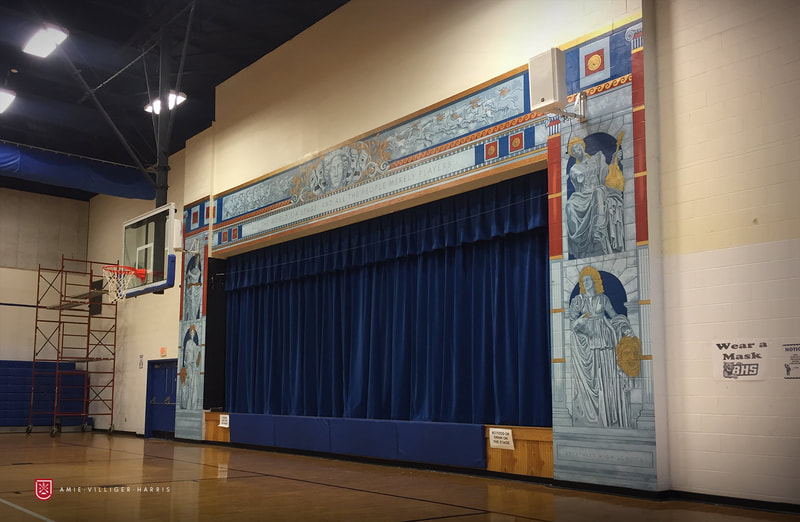



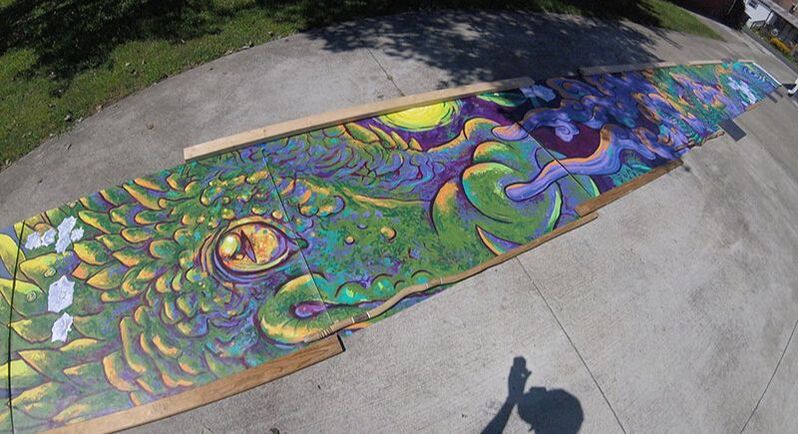



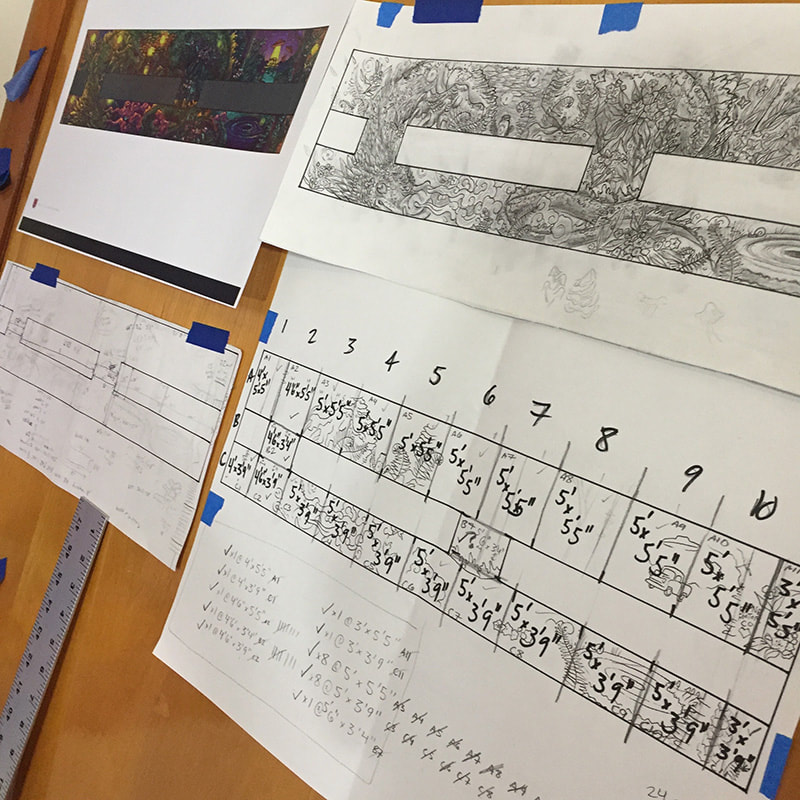
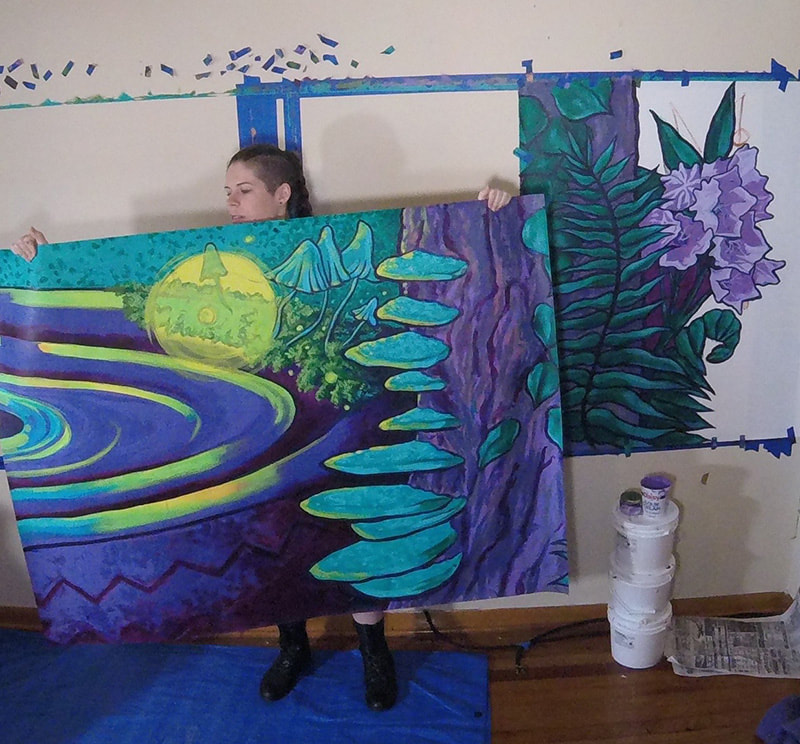





 RSS Feed
RSS Feed
